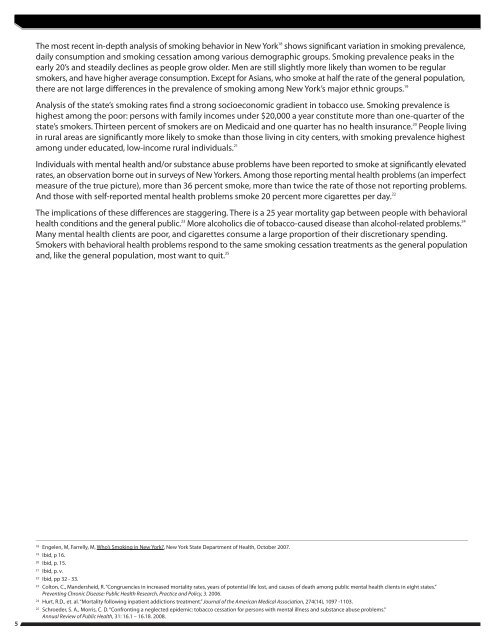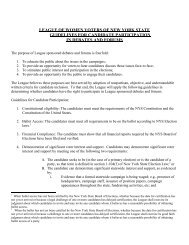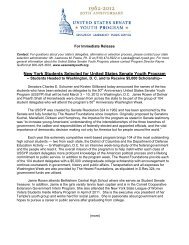UP IN SMOKE: - American Cancer Society
UP IN SMOKE: - American Cancer Society
UP IN SMOKE: - American Cancer Society
You also want an ePaper? Increase the reach of your titles
YUMPU automatically turns print PDFs into web optimized ePapers that Google loves.
5<br />
The most recent in-depth analysis of smoking behavior in new York 18 shows significant variation in smoking prevalence,<br />
daily consumption and smoking cessation among various demographic groups. Smoking prevalence peaks in the<br />
early 20’s and steadily declines as people grow older. Men are still slightly more likely than women to be regular<br />
smokers, and have higher average consumption. Except for Asians, who smoke at half the rate of the general population,<br />
there are not large differences in the prevalence of smoking among new York’s major ethnic groups. 19<br />
Analysis of the state’s smoking rates find a strong socioeconomic gradient in tobacco use. Smoking prevalence is<br />
highest among the poor: persons with family incomes under $20,000 a year constitute more than one-quarter of the<br />
state’s smokers. Thirteen percent of smokers are on Medicaid and one quarter has no health insurance. 20 People living<br />
in rural areas are significantly more likely to smoke than those living in city centers, with smoking prevalence highest<br />
among under educated, low-income rural individuals. 21<br />
individuals with mental health and/or substance abuse problems have been reported to smoke at significantly elevated<br />
rates, an observation borne out in surveys of new Yorkers. Among those reporting mental health problems (an imperfect<br />
measure of the true picture), more than 36 percent smoke, more than twice the rate of those not reporting problems.<br />
And those with self-reported mental health problems smoke 20 percent more cigarettes per day. 22<br />
The implications of these differences are staggering. There is a 25 year mortality gap between people with behavioral<br />
health conditions and the general public. 23 More alcoholics die of tobacco-caused disease than alcohol-related problems. 24<br />
Many mental health clients are poor, and cigarettes consume a large proportion of their discretionary spending.<br />
Smokers with behavioral health problems respond to the same smoking cessation treatments as the general population<br />
and, like the general population, most want to quit. 25<br />
18 Engelen, M, Farrelly, M, Who’s Smoking in new York?, new York State Department of Health, october 2007.<br />
19 ibid, p 16.<br />
20 ibid, p. 15.<br />
21 ibid, p. v.<br />
22 ibid, pp 32 - 33.<br />
23 Colton, C., Mandersheid, R. “Congruencies in increased mortality rates, years of potential life lost, and causes of death among public mental health clients in eight states.”<br />
Preventing Chronic Disease: Public Health Research, Practice and Policy, 3. 2006.<br />
24 Hurt, R.D., et. al. “Mortality following inpatient addictions treatment.” Journal of the <strong>American</strong> Medical Association, 274(14), 1097 -1103.<br />
25 Schroeder, S. A., Morris, C. D. “Confronting a neglected epidemic: tobacco cessation for persons with mental illness and substance abuse problems.”<br />
Annual Review of Public Health, 31: 16.1 – 16.18. 2008.
















